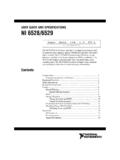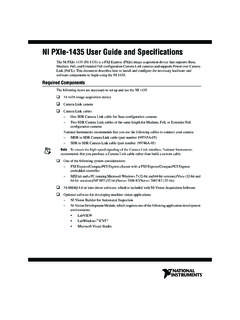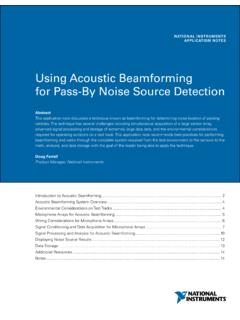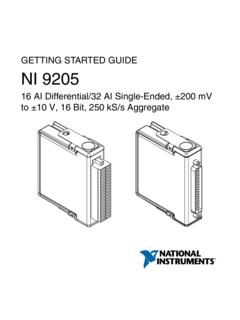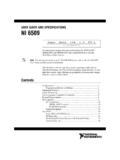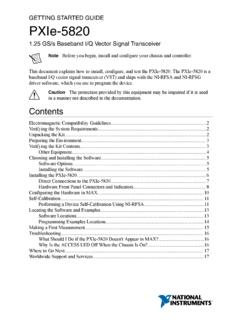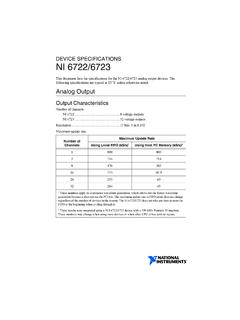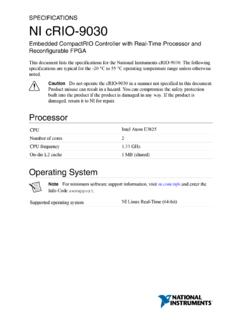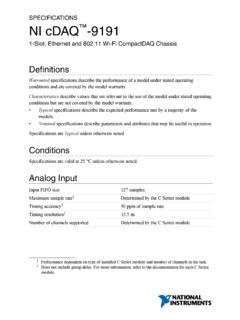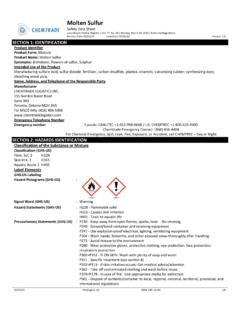Transcription of GPIB Hardware Installation Guide and Specifications ...
1 Installation Guide AND Specifications . GPIB Hardware Contents Electromagnetic Compatibility Guidelines .. 2. AT-GPIB/TNT (PnP) .. 2. GPIB-USB Interfaces .. 3. LED Signaling .. 5. NI PCIe-GPIB, NI PCIe-GPIB+, PCI-GPIB, PCI-GPIB+, PCI-GPIB/LP, and PCI-8232 .. 6. PCMCIA-GPIB .. 7. NI ExpressCard-GPIB .. 9. PMC-GPIB .. 10. PXI-GPIB and 12. GPIB-ENET/100 .. 14. GPIB-ENET/100 Installation .. 14. Baseplate Identification Label .. 15. 15. Software Recognition .. 16. Ethernet Configuration .. 16. PWR/RDY LED 20. CFG RESET Switch .. 21. GPIB-ENET/1000 .. 22. GPIB-ENET/1000 Installation .. 22. Baseplate Identification Label .. 23. 24. Ethernet Connector 25. Software Recognition .. 25. Ethernet Configuration .. 25. Firmware Update .. 28. READY LED Signaling .. 28. CFG RESET Switch .. 29. 30. AT-GPIB/TNT (Plug and Play).. 30. ExpressCard-GPIB .. 30. GPIB-ENET/100 .. 31. GPIB-ENET/1000 .. 32. GPIB-USB-B .. 33. 34. GPIB-USB-HS+ .. 35. 36. NI PCIe-GPIB and NI PCIe-GPIB+.
2 37. 38. PCI-GPIB+.. 39. 40. 40. 41. 42. All Devices .. 43. Worldwide Support and Services .. 46. Electromagnetic Compatibility Guidelines This product was tested and complies with the regulatory requirements and limits for electromagnetic compatibility (EMC) stated in the product Specifications . These requirements and limits provide reasonable protection against harmful interference when the product is operated in the intended operational electromagnetic environment. This product is intended for use in industrial locations. However, harmful interference may occur in some installations, when the product is connected to a peripheral device or test object, or if the product is used in residential or commercial areas. To minimize interference with radio and television reception and prevent unacceptable performance degradation, install and use this product in strict accordance with the instructions in the product documentation. Furthermore, any modifications to the product not expressly approved by National Instruments could void your authority to operate it under your local regulatory rules.
3 Caution To ensure the specified EMC performance, operate this product only with shielded cables and accessories. AT-GPIB/TNT (PnP). Caution Electrostatic discharge can damage several components on your GPIB. board. To avoid such damage in handling your board, touch the antistatic plastic package to a metal part of your computer chassis before removing the board from the package. Complete the following steps to install your interface: 1. Make sure that your computer is powered off. Keep the computer plugged in so that it remains grounded while you install the GPIB Hardware . 2. Remove the top cover (or other access panels) to gain access to the computer expansion slots. 3. Find an unused expansion slot in your computer. The AT-GPIB/TNT (PnP) board requires a 16-bit ISA expansion slot. 4. Remove the corresponding slot cover on the back panel of the computer. 2 | | GPIB Hardware Installation Guide and Specifications 5. Insert the GPIB board into the slot with the GPIB connector sticking out of the opening on the back panel, as shown in Figure 1.
4 It might be a tight fit, but do not force the board into place. Figure 1. Installing the AT-GPIB/TNT (PnP). 6. Screw the mounting bracket of the GPIB board to the back panel rail of the computer. 7. Replace the top cover (or the access panel to the expansion slot) and power on your computer. The GPIB Hardware Installation is now complete. GPIB-USB Interfaces Caution Ground loops create an electric shock hazard and can cause damage to your GPIB-USB Hardware , your computer, and other system components. A ground loop can occur when your computer and one or more connected instruments do not share the same ground potential. To prevent damage to your GPIB-USB Hardware and other system components, do any of the following: Ensure that your system and all instruments connected to it share the same ground potential. This eliminates the possibility of voltage differential running through your system. Use an NI GPIB-120B Bus Isolator/Expander to isolate GPIB systems and expand the GPIB interface up to 28 devices.
5 GPIB Hardware Installation Guide and Specifications | National Instruments | 3. Use a pair of NI GPIB-140A High-Speed Fiber-Optic Bus Extenders. This transforms the GPIB signals at each end into fiber optic signals, allowing each unit to reside at a different ground potential. Use an isolated USB hub. Complete the following steps to install your interface: 1. Connect the USB connector from the GPIB-USB interface to an available USB Type A port on your computer. 2. Before connecting the GPIB-USB interface to GPIB devices, ensure that the computer and the GPIB devices are at the same ground potential. The GPIB-USB interface connects directly to most GPIB devices without requiring a GPIB cable. 3. If your computer is already running, the operating system automatically detects the GPIB. interface. Otherwise, the GPIB interface is detected when you start your computer. Figure 2. Installing the GPIB-USB Interface 1. 2. 3. 4. 1 Computer 2 USB Connector 3 GPIB-USB Interface 4 To GPIB Devices The GPIB Hardware Installation is now complete.
6 4 | | GPIB Hardware Installation Guide and Specifications LED Signaling The GPIB-USB-HS controller uses two LEDs to indicate status and activity. When you connect the GPIB-USB-HS controller, the READY LED lights either green or amber once the driver is installed and detected. Table 1 summarizes the functionality of the LEDs on the GPIB-USB-HS Hardware . Table 1. GPIB-USB-HS LED Descriptions LED Description READY Green indicates that the GPIB-USB-HS is plugged into a USB full-speed (USB ) port. Amber indicates that the GPIB-USB-HS is plugged into a USB Hi-Speed (USB ) port. ACTIVE Indicates activity on the GPIB bus. The GPIB-USB-HS+ controller uses a multicolored LED to indicate status and activity. Table 2. summarizes the functionality of the LEDs on the GPIB-USB-HS+ Hardware . Table 2. GPIB-USB-HS+ LED Descriptions LED Description Alternating The GPIB-USB-HS+ is not ready to use. You must install (or re-install). Amber/Green the driver before using the GPIB-USB-HS+.
7 Note: Windows 8 and later suspend power to a USB device that does not have a driver attached. If the LED does not light, try reinstalling the driver. Steady Green Indicates that the GPIB-USB-HS+ is plugged into a USB full-speed (USB ) port. Steady Amber Indicates that the GPIB-USB-HS+ is plugged into a USB Hi-Speed (USB ) port. Blinking Amber Indicates activity on the GPIB bus or that the GPIB Analyzer is or Green capturing. GPIB Hardware Installation Guide and Specifications | National Instruments | 5. NI PCIe-GPIB, NI PCIe-GPIB+, PCI-GPIB, PCI-GPIB+, PCI-GPIB/LP, and PCI-8232. Caution Electrostatic discharge can damage several components on your GPIB. board. To avoid such damage in handling your board, touch the antistatic plastic package to a metal part of your computer chassis before removing the board from the package. Complete the following steps to install your interface: 1. Make sure that your computer is powered off. Keep the computer plugged in so that it remains grounded while you install the GPIB Hardware .
8 2. Remove the top cover (or other access panels) to gain access to the computer expansion slots. 3. Find an unused expansion slot in your computer. Your PCI board can be plugged into either a V or 5 V, 32- or 64-bit PCI slot. Your PCI Express card can be plugged into a x1, x4, x8, or x16 PCI Express slot. 4. Remove the corresponding slot cover on the back panel of the computer. 5. Insert the GPIB board into the slot with the GPIB connector sticking out of the opening on the back panel, as shown in Figure 3. It might be a tight fit, but do not force the board into place. Note Your PCI Express board may be larger than the one shown in the figure. 6 | | GPIB Hardware Installation Guide and Specifications Figure 3. Installing Your PCI/PCI Express Board 3 3. 2 2. 1 1. 1 PCI Express Board 3 Computer 1 PCI Board 3 Computer 2 PCI Express Slot 2 PCI Slot 6. Screw the mounting bracket of the GPIB board to the back panel rail of the computer. 7. Replace the top cover (or the access panel to the expansion slot).
9 8. Power on your computer. The GPIB Hardware Installation is now complete. PCMCIA-GPIB. Caution Ground loops create an electric shock hazard and can cause damage to your PCMCIA-GPIB Hardware , your computer, and other system components. A. ground loop can occur when your computer and one or more connected instruments do not share the same ground potential. To prevent damage to your PCMCIA-GPIB Hardware and other system components, do any of the following: Ensure that your system and all instruments connected to it share the same ground potential. This eliminates the possibility of voltage differential running through your system. Use an NI GPIB-120B Bus Isolator/Expander to isolate GPIB systems and expand the GPIB interface up to 28 devices. Use a pair of NI GPIB-140A High-Speed Fiber-Optic Bus Extenders. This transforms the GPIB signals at each end into fiber optic signals, allowing each unit to reside at a different ground potential. GPIB Hardware Installation Guide and Specifications | National Instruments | 7.
10 Complete the following steps to install your interface: 1. Reboot the computer. 2. If the PCMCIA-GPIB is not already inserted, insert it into a free PC Card (PCMCIA). socket. The card has no jumpers or switches to set, and you do not need to power down the system when you insert it. 3. Before connecting the PCMCIA-GPIB interface to GPIB devices, ensure that the computer and the GPIB devices are at the same ground potential. Figure 4 shows how to insert the PCMCIA-GPIB and how to connect the cable. Figure 4. Inserting the PCMCIA-GPIB. 1. 2. 3. RD. CA. RT. SE. IN. 1 Notebook Computer 2 PCMCIA Socket 3 PCMCIA-GPIB Cable The GPIB Hardware Installation is now complete. 8 | | GPIB Hardware Installation Guide and Specifications NI ExpressCard-GPIB. Caution Ground loops create an electric shock hazard and can cause damage to your NI ExpressCard-GPIB Hardware , your computer, and other system components. A ground loop can occur when your computer and one or more connected instruments do not share the same ground potential.
